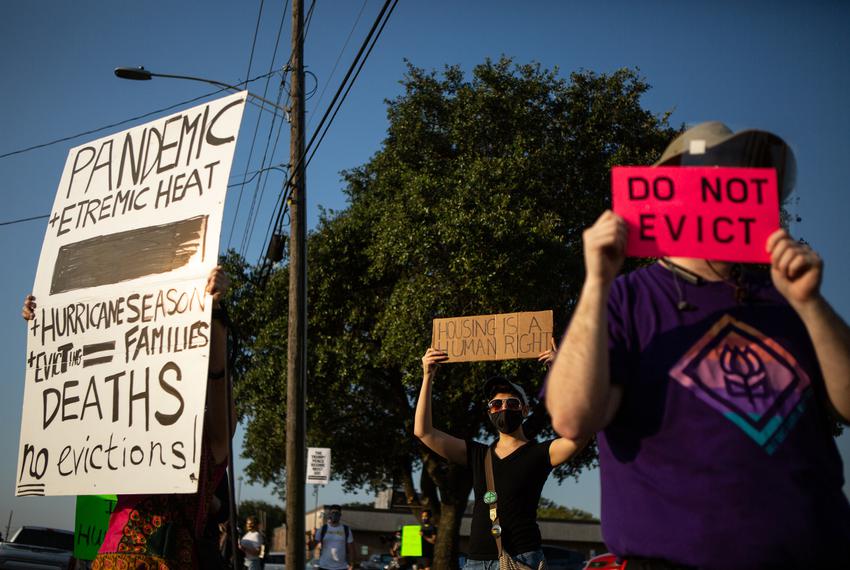From The Texas Tribune:
Charmayne Hunter’s faith has centered her amid the hurdles of acquiring rental assistance.
Her energy is focused on finding a job and ensuring she can pay her rent, which is about $1,500 a month, before the assistance she’s already worked so hard to obtain dries up at the end of August.
After her father’s death almost a year ago, she was laid off from her job as a substance abuse counselor with Volunteers of America. Then she and her husband separated. That series of events put her in a financial bind, she said, and she applied for two rental assistance programs — one through the state and another through Harris County. It was a frustrating process filled with slow response times and confusing bureaucracy, she said.
“I don’t allow myself to worry if something’s going to be cut off,” said Hunter, 47, who lives in Atascocita, near Houston. “I mean, I just know God got it. That’s just my philosophy, seriously. I had to get to that point.”
With the federal moratorium on evictions ending Saturday and COVID-19 cases rising with the arrival of the highly contagious delta variant, some Texans are scrambling to find rental assistance at the local or state level. In a statement released in June, the U.S. Centers for Disease Control and Prevention was adamant that its most recent extension of the federal moratorium would be its last, putting pressure on states — which have been allocated hundreds of millions of dollars in emergency rental assistance funds from the federal government — to get the money to those it was intended to help.
Guidelines instructing justices of peace about how the moratorium should be implemented in Texas expired in March. Since then, judges have applied the moratorium inconsistently; some made tenants aware of the moratorium during eviction hearings, but others did not.
“It’s given some relief, but only limited,” Mark Melton, an attorney with the Dallas Eviction Advocacy Center, said of the CDC’s order. “Most of the courts in Texas are just ignoring it. And so, if a landlord wants to move forward with an eviction, they just let them.”
It’s not clear exactly how many evictions in Texas will proceed once the CDC moratorium ends. Thorough statewide data on evictions is scarce, but according to the Texas Office of Court Administration, the number of cases filed — evictions sought by landlords and demands for necessary repairs by tenants — fell 28% during the year that ended Aug. 31, 2020.
But this year, from late June to early July, more than 600,000 Texas households said they were behind on their rent payments, according to a recent Census Bureau survey. The majority of those tenants were Black and Hispanic.
According to data from the Eviction Lab, a research project at Princeton University that conducts research on evictions nationwide, eviction filings fell sharply in major metro areas such as Houston, Austin and Dallas during the Texas Supreme Court’s eviction moratorium, which remained in place from March to May 2020. Evictions in the three cities bottomed out in April 2020, with filings down more than 80% from their normal average in each city.
After the state moratorium expired, June 2020 eviction filings in Houston and Dallas were down about 60% from average. In Austin, which joined with Travis County to extend local eviction orders until Aug. 1, eviction filings rose slightly, but remained 84% or more below average.
“Tens of thousands [of pending evictions] across the state, easily, are just sitting there in abatement waiting until the CDC order expires,” Melton said. “And the second [the moratorium] expires, the landlord or the court will call for another hearing, and they’re all going to go through. If there’s no CDC declaration, those evictions are just going to go through.”
Shifting attention to state and local relief
With the federal eviction moratorium ending, advocates and those providing legal aid to tenants, such as Melton, have been shifting their attention to making sure tenants take advantage of state and local options, especially tenants on the cusp of eviction.
Under the Texas Eviction Diversion Program — a partnership of the Texas Department of Housing and Community Affairs, the Texas Supreme Court and the Texas Office of Court Administration — eviction proceedings can be delayed up to 60 days if both the tenant and the landlord agree to participate, and an eviction can be scrubbed from public records if an application is approved and a landlord receives payment for unpaid rent.
Landlords can still decide anytime during the 60-day period to reinstate an eviction, which basically negates the intentions of the program, said K’Lisha Rutledge, an attorney with Legal Aid of NorthWest Texas.
“There’s a lot of cases where tenants are getting evicted that have already been approved for rental assistance,” Rutledge said. “And their landlord knows that they’ve been approved, and they’re just waiting on the check.”
A recently revised emergency order from the state Supreme Court that extends the eviction diversion program until Oct. 1 attempts to remedy this situation, said David Slayton, administrative director of the Texas Office of Court Administration, which provides support and guidance to the state’s judicial branch. Under the order, justices of the peace are required to confirm with landlords whether there are pending applications for rental assistance before moving forward with an eviction case. If so, a judge can pause the eviction case and make the filing confidential.
One key to making sure the eviction diversion program works smoothly, however, is that justices of the peace abide by the emergency orders and alert tenants that rental relief is available to them, said Christina Rosales, deputy director of Texas Housers, a nonprofit that addresses housing and community development issues with an emphasis on low-income communities.
“What we’ve seen is that, actually, there are not a lot of judges that are complying with all of the guidance and [with] policies that have been in place,” Rosales said. “A lot of judges don’t ask about the CDC moratorium, they don’t even bring up rental relief, or they just don’t ask tenants any questions.”
Slayton said the Office of Court Administration takes accusations such as these seriously.
“I think [justices of the peace] who don’t follow the requirements of the law or the Supreme Court’s orders are subject to discipline by the State Commission on Judicial Conduct,” Slayton said. “I can guarantee they don’t intentionally not follow the rules. If there’s situations where that’s not happening, then someone needs to know so we can make them aware of what they should be doing, and we’re happy to play that role.”
David Mintz, vice president of government affairs for the Texas Apartment Association, a trade group of rental property owners, said eviction is usually a last resort after landlords have exhausted all other options, and it’s usually not a swift process, especially with rental relief being made available to tenants.
“I think a lot of owners who have participated in the eviction diversion program have had good success,” Mintz said. “I do think that there may be reasons why somebody may not want to participate in the program … and we’ve certainly throughout the program worked to educate our members about that as being an option for them to consider.”
Mintz said there are two possible reasons landlords may not wish to participate in the program: They are ready to move on to a new tenant, or they don’t want to be obligated by program rules.
“Once again, it’s a great tool to consider,” Mintz said of the eviction diversion program. “It is showing itself to be working in a lot of cases. I think it’s important to keep in mind as well [that] by the time somebody has gotten to this point, there’s been a lot of effort and a lot of communication, and it just may be that [landlords] decided they’d rather not participate.”
In January, Texas received about $2 billion in emergency rental assistance money from the federal government, part of the first phase of funds from the federal Emergency Rental Assistance Program. From those funds, about $1.3 billion was set aside for the state-run Texas Rent Relief Program, which started accepting applications in February, and the rest was given to cities and counties.
Currently, about 40 Texas cities and counties administer some form of emergency rental assistance program, according to Texas Housers. The state rental relief program is also set to receive almost $1.1 billion in the second phase of the federal ERA program, according to the Texas Department of Housing and Community Affairs, which administers the Texas Rent Relief Program.
“We’re at a time where this rental assistance that’s available, the scale of it, we’ve never seen this before, ever,” Rosales said.
Through the Texas Rent Relief Program, tenants can apply to receive up to 15 months of rental and utility assistance, with some caveats: A tenant’s household income must be at or below 80% of the median income in their area or they receive some type of government public assistance, and they have to attest they are at risk of losing housing or that if they do not receive assistance, they will have to move to an unsafe or unhealthy environment during the pandemic.
Tenants are allowed to apply every three months if funds are available, according to the TDHCA, and if a landlord opts not to receive direct payment or has not responded after repeated outreach, payments can be sent directly to tenants.
Some advocates have criticized the program for its slow start and for delays in tenants receiving assistance once their applications have been approved, a problem they say persists for some Texans.
Roegina Perez, who lives in Converse, outside of San Antonio, said she’s been proactive in her search for rental assistance. After she lost her job as an office assistant earlier this year, she entrenched herself in research about the Texas Rent Relief Program so she could thoroughly understand the application process and explain it to her landlord.
“I needed to understand it myself, so I was pretty well versed in the program rules and the breakdown,” said Perez, 43. “But none of it went that way, none of it went the way it was supposed to.”
She applied for the program in March and received approval for her application in June. But neither she nor her landlord has seen any funds materialize in their accounts, she said. Her landlord had been patient with her, however, as she picked up temporary work here and there and chipped away at almost $3,000 in back rent for the one-bedroom apartment that she shares with her 6-year-old daughter.
“He’s been patient up until recently. We felt relieved when I got approved and they were going to disperse, and then when nothing came, it was like everybody sort of felt scammed. He just contacted me this week like, ‘We gotta work something out.’ … We’re kind of just functioning as if [the rent relief] is not an option.”
Kristina Tirloni, a TDHCA spokesperson, said in an emailed statement that the TDHCA is “working closely with landlords and utilities to set up direct deposit to make this process as smooth and efficient as possible.”
As of July 26, more than 95,000 households have received assistance from the Texas Rent Relief Program, and almost $600 million in relief has been paid out, according to the TDHCA. The department expects to use up its initial batch of ERA funds well before Dec. 31, Tirloni said.
Although she’s grateful for the almost $6,000 she received in rental assistance from the state program, Hunter said the program was frustrating to navigate and it took months for the aid to arrive after she applied.
This month, she said, her gas was shut off because her utility company was not alerted that she would be receiving utility assistance, and it took days to find someone with Texas Rent Relief who could intervene to get it turned on again.
Hunter spends most of her time searching for a new job. For the moment, she said, she is OK, but she worries about the possibility she’ll once again have to apply for rental assistance if she can’t find work by the end of August.
“I don’t want to face this again,” she said.
Disclosure: The Texas Apartment Association has been a financial supporter of The Texas Tribune, a nonprofit, nonpartisan news organization that is funded in part by donations from members, foundations and corporate sponsors. Financial supporters play no role in the Tribune’s journalism. Find a complete list of them here.














